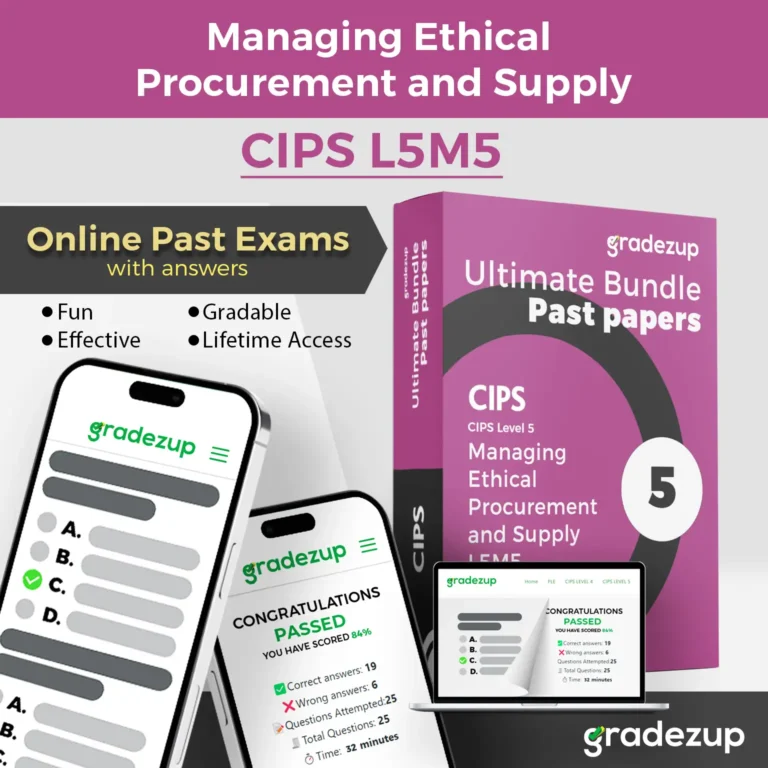
Ready to excel in your CIPS L5M5 Exams

Time's up

Time is Up!
✨ Premium Access ✨
 Access more CIPS L5M5 Exam Past Papers
Access more CIPS L5M5 Exam Past Papers 
Note: $4.99 grants you access to all papers (paper 1 – paper 10)
Gain access using
L5M5 Quick Exam-Ready Summary:
- Core Module
- Objective / Response Exam
- 1.5 hours Exam duration
- 60 Questions in exam
- 6 Credits Score
Principles of Ethical Sourcing
Definitions of ethics, CSR, ESG; codes of conduct; anti-bribery; conflicts of interest
Legal & Policy Frameworks
Modern Slavery Act; environmental & labour regulations; CSR policies; whistleblowing
Ethical Risks in Supply Chains
Modern slavery, unsafe work, corruption, environmental harm, greenwashing
Tools for Responsible Sourcing
Supply chain mapping, risk matrices, audits, certifications, supplier codes, collaboration
Embedding & Monitoring Ethical Practice
KPIs, sustainability reporting (GRI, CDP), continuous improvement, governance & culture
CIPS L5M5 Exam Focus Areas – 2025 (Master List)
“These are core learning areas, but CIPS may include questions from other parts of the syllabus.” ⚠️
1. Principles of Ethical and Responsible Sourcing
- Ethical Procurement Foundations:
- Definitions: ethics, integrity, corporate social responsibility (CSR), sustainable procurement
- Importance of fairness, transparency, accountability in procurement
- Codes of ethics and conduct (CIPS Code of Ethics, UN Global Compact)
- Anti-bribery, corruption, and fraud prevention measures (UK Bribery Act, FCPA)
- Conflicts of interest and disclosure requirements
- Responsible Sourcing Concepts:
- Triple bottom line (economic, environmental, social performance)
- ESG factors (Environmental, Social, Governance) in procurement
- OECD Guidelines for Multinational Enterprises and UN Guiding Principles on Business and Human Rights
- Sustainable Development Goals (SDGs) and procurement’s role
2. Legal, Regulatory, and Policy Frameworks
- Legislation & Regulations:
- Modern Slavery Act (UK) and global equivalents
- Environmental regulations: REACH, RoHS, waste management laws
- Labour standards: ILO conventions, minimum wage, health & safety
- Public procurement directives (EU, WTO GPA principles)
- Organisational Policies:
- Corporate social responsibility policies
- Procurement policy statements and supplier charters
- Whistleblowing and reporting mechanisms
- Integration of ethics into procurement strategy
3. Ethical Risks and Issues in Global Supply Chains
- Common Ethical Risks:
- Modern slavery, forced labour, child labour
- Unsafe or unfair working conditions
- Corruption, bribery, and facilitation payments
- Environmental damage from supply chains (deforestation, emissions, waste)
- False or misleading sustainability claims (greenwashing)
- Risk Drivers in Global Supply Chains:
- Outsourcing to low-cost countries
- Complex multi-tier supply chains and lack of visibility
- Cultural differences and governance gaps
- Short-term cost pressures and trade-offs
4. Tools and Approaches for Ethical and Responsible Sourcing
- Risk Identification and Assessment:
- Supplier pre-qualification questionnaires
- Supply chain mapping for visibility beyond tier 1
- Risk matrices for ethical and sustainability risks
- Management and Control Mechanisms:
- Supplier codes of conduct and contractual clauses
- Audits, site visits, and third-party assurance
- Certification schemes (Fairtrade, FSC, Rainforest Alliance, ISO 14001/26000, SA8000)
- Ethical sourcing standards: ETI Base Code
- Collaboration and Engagement:
- Supplier development and training on ESG issues
- Multi-stakeholder initiatives (Sedex, Ethical Trading Initiative)
- Industry coalitions for responsible sourcing
5. Embedding and Monitoring Ethical Procurement
- Monitoring and Measurement:
- KPIs: % of suppliers audited, % with ethical certifications, carbon footprint, diversity measures
- Sustainability reporting frameworks: GRI, CDP, Integrated Reporting
- Balanced scorecard for ethical sourcing
- Continuous Improvement:
- Lessons learned from supply chain scandals (e.g., Rana Plaza)
- Benchmarking best practice in ethical sourcing
- Regular review of supplier relationships and ethical risk exposure
- Organisational Culture & Governance:
- Tone from the top: leadership commitment to ethics
- Training and awareness for procurement teams
- Incentives for ethical behaviour and penalties for misconduct
View more CIPS Exams
Select the Exams you want to practice

